
Paul Morris
_____
Album covers: to those who grew up in the vinyl era, the images printed on the sleeves of LPs were closely linked in our imaginations with the music they represented. The iconic covers of the ’60s – Sgt. Pepper, The Band at Big Pink, Cheap Thrills drawn by R. Crumb – put an enduring visual stamp on the pop culture of the time.
This art form has a relatively short history – only in the ’40s were 78 rpm album covers routinely decorated with art. But in its first two decades, the field of album cover design quickly matured, producing mini-posters that tried to entice music buyers with hand-drawn designs of striking beauty and originality.
I am a collector of these early album covers and those that followed in the early LP era. In this corner of Jerry Jazz Musician I will have a chance to share my enthusiasm for the artists who created album covers in the ’40s and ’50s.
By profession I am a graphic designer, and I have gravitated toward the covers of the leading designers of the time, such as Alex Steinweiss, Eric Nitsche, and Jim Flora. Besides good design, though, I have a taste for the odd, and as any vinyl shopper knows, the ’50s produced a lavish amount of visual camp and shlock. I will share my examples of dated and strange fashions, styles, and slogans.
If you came to visit me, I would play for you something from my collection of jazz LPs and CDs, but while we were listening I would beg you to have a look at the latest additions to my album cover collection. In a given week in the abundant used-record stores in Portland I might have found a half-dozen fine designs from the ’40s and as many bizarre commercial efforts from the cheesy ’50s.
We album art collectors look for items in various “categories” that interest us. One person might collect covers showing someone smoking; another person might want every cover of recordings of Dvorak’s New World Symphony. I am keenly interested in certain designers, including Steinweiss and Kurt John Witt. I also hunt for pictures of teenage dance parties, San Francisco, and records on the floor. More to come on categories.
For this first installment I have some covers by Alex Steinweiss (1917-2011), known as the father of the record album cover, and for many years in charge of Columbia Records’ art department.
_____
The Benny Goodman Sextet cover from 1945 is an example of Steinweiss’s early style, when the illustrator’s pen and brush were his main tools. He relied on flat fields of color and objects that symbolized or referred to the music. Here the instruments of the sextet and surrounded by café tables bearing bold letters. The striking Basie illustration shows clearly how these covers were printed with spot colors rather than four-color process colors. It was printed with three inks: black, blue, and red. The light pole is a recurring element in his drawings.
These were albums of 78 rpm 10-inch records. Four to six records, one song per side, in paper sleeves, were bound together in heavy cardboard covers. The linen cloth covering the spine was dyed to complement the cover art. Long-playing 33-rpm and 45-rpm records didn’t arrive until the late ’40s.
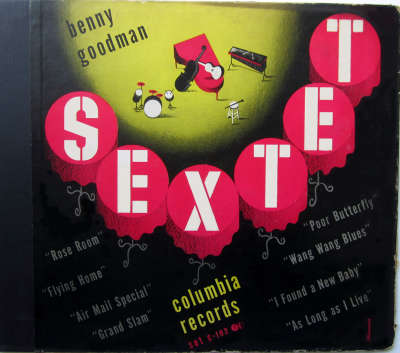
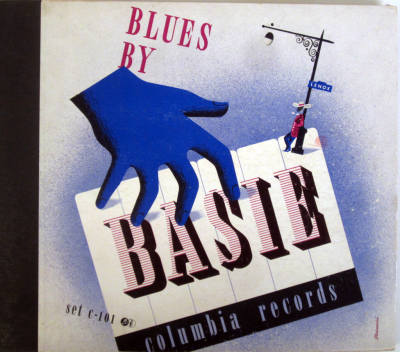
______
The Xavier Cugat and Showboat covers use a similar color palette. The anthropomorphic conga drum is paired with large stencil type that the designer seems to think had a south-of-the-border feel. In Showboat, I like how the small figures are arrayed across the green field next to the riverboat. I can’t help thinking of a prison yard when I see this cover, but that’s probably just me. The wood frame was a look that Steinweiss tried out and didn’t repeat.
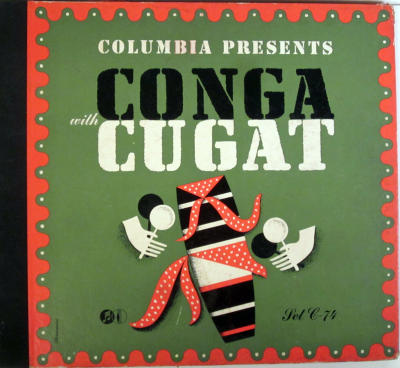
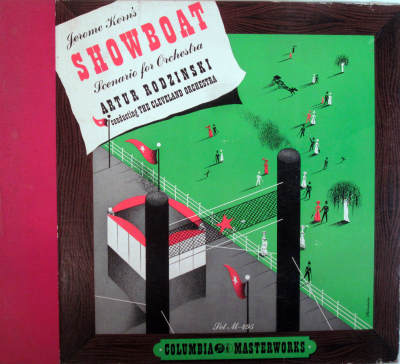
_____
Later in the ’40s Steinweiss created more intricate illustrations. In the Pastoral Symphony don’t miss the peasants dancing beneath the lower tree and the crack of lightning at the top. These refer to program elements in the symphony. The gravity-challenged trees are Steinweiss’s own idea. In the Tchaikovsky cover, the shape of the scroll on the neck of the violin, a favorite motif, is central. Here it encloses a drawing of a Russian cathedral and urban scene. The typeface, Bodoni Poster, was a mainstay.
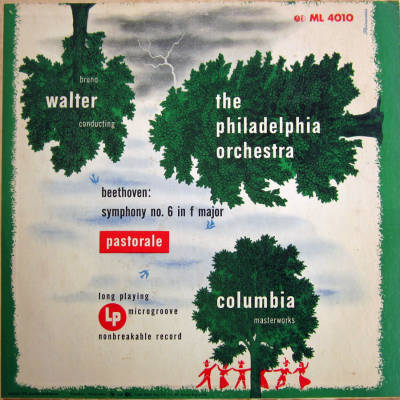

______
I like the feeling of mystery this illustration evokes. It’s one of several pieces that seem influenced by de Chirico and the surrealist artists of the ’30s. I don’t know what the “Desert Song” is about, but those five riders are armed! The background is a photograph of sand dunes that is faded and screened.
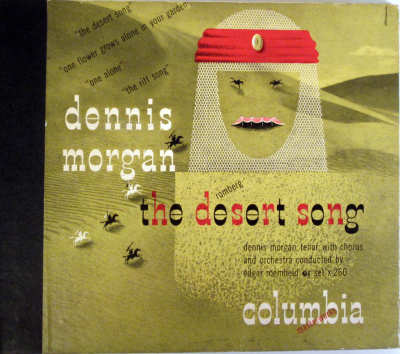
_____
Steinweiss knew classical music and left the jazz to other designers for the most part. Here he achieves a delicate effect with the interplay of heart shapes and butterfly wings. The singer’s name is handwritten in a script that became a hallmark of Steinweiss covers. Later called the Steinweiss Scrawl, it originated as a practical solution to the limited range of type available to him at the original Columbia art studio in Bridgeport, Connecticut.
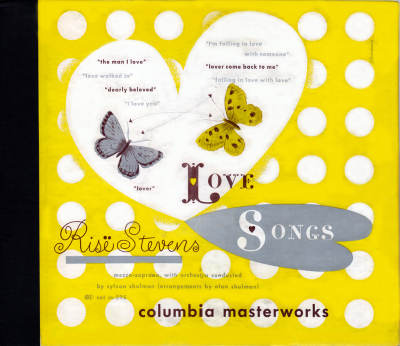
_____
And as a hint of covers to come, I’ll skip forward ten years for a glimpse of the later Steinweiss, after he departed Columbia and freelanced for Decca and others. Just the colors tell us we’re not in the ’40s anymore. This photographed collage displays just one of the stylistic faces he adopted later in his career. Representation is left behind in this evocation of Stravinsky and Bartók. During these years he signed his Decca work “Piedra Blanca” to differentiate the new work from his well-known Columbia styles. The name is the Italian equivalent to Steinweiss-white stone.
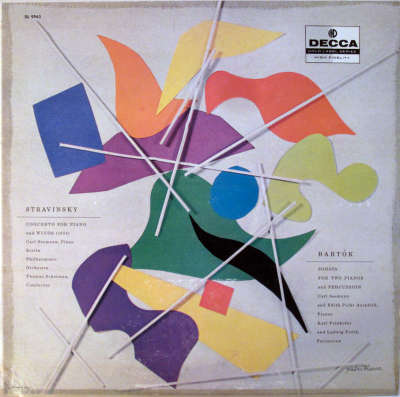
*
On the next edition I’ll be sharing scans of covers from Columbia, the greatest record label, measured by achievement in graphic design. Steinweiss set a high standard at Columbia, and his successors upheld it.








































Awesome, Paul. Can’t wait to see the next installment. I think I favor his later period.
Great article. It’d be nice to get the wonderful album covers even larger on the screen, like a double-click opens to full screen. Keep on collectin’ Paul!
Very cool site, Paul!
This is a really cool segment, Paul! So much to be said for album cover art as its own artistic medium.
Love the Stravinsky cover.
Paul, I did not even known there were collectors like you of record sleeves; I compliment
you on your fab. interest and collection. I liked Goodman and Stravinsky/Bartok the best.
More, please.
Best
Girish